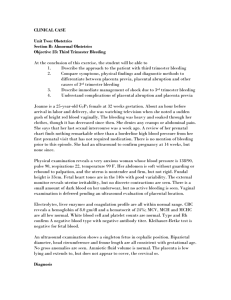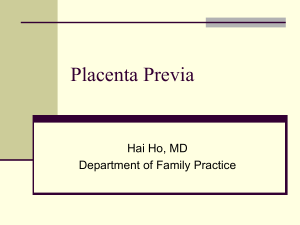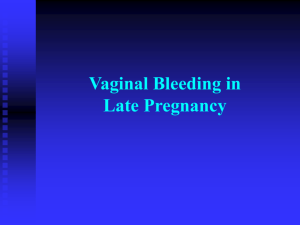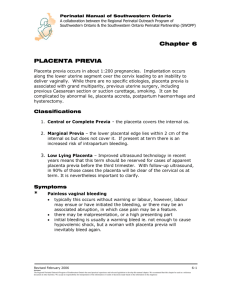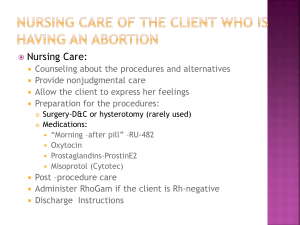Indications For Obstetrical Ultrasound Examinations: Focus On Third
advertisement
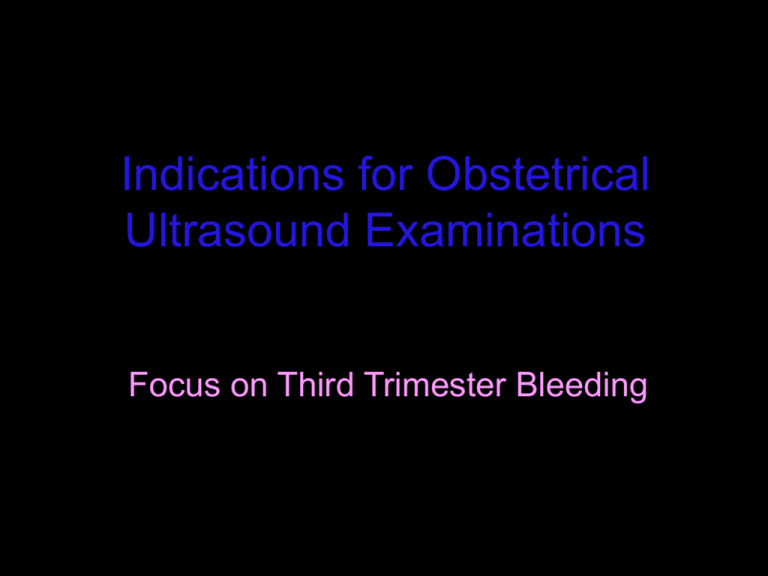
Indications for Obstetrical Ultrasound Examinations Focus on Third Trimester Bleeding Indications: •Confirm presence of an intrauterine pregnancy •Suspected ectopic pregnancy •Estimation of gestational age •Vaginal bleeding •Significant uterine size and dates discrepancy •Suspected multiple gestation •Evaluation of a pelvic mass or pelvic pain •Evaluation of fetal growth •Adjunct to amniocentesis, chorionic villus biopsy, fetal blood sampling •Suspected hydatidiform mole •Evaluation of incompetent cervix and/or risk of preterm delivery •Adjunct to cervical cerclage placement •Adjunct to special diagnostic or therapeutic procedures on the fetus •Confirm fetal viability or fetal death Indications (cont): •Suspected uterine abnormality •Adjunct to localization and removal of an intrauterine contraceptive device •Biophysical fetal evaluation •Suspected oligohydramnios or polyhydramnios •Suspected abruptio placentae •Adjunct to external cephalic version •Estimation of fetal weight •Determination of fetal presentation •Abnormal maternal serum analytes •Follow-up of observed fetal anomaly •Identification and follow-up of placental previa •History of previous congenital anomaly •Serial evaluation of fetal growth in multiple gestation •Evaluation of fetal condition in late registrants for prenatal care Indications – 3rd Trimester: •Confirm presence of an intrauterine pregnancy •Suspected ectopic pregnancy •Estimation of gestational age •Vaginal bleeding •Significant uterine size and dates discrepancy •Suspected multiple gestation •Evaluation of a pelvic mass or pelvic pain •Evaluation of fetal growth •Adjunct to amniocentesis, chorionic villus biopsy, fetal blood sampling •Suspected hydatidiform mole •Evaluation of incompetent cervix and/or risk of preterm delivery •Adjunct to cervical cerclage placement •Adjunct to special diagnostic or therapeutic procedures on the fetus •Confirm fetal viability or fetal death Indications – 3rd Trimester (cont): •Suspected uterine abnormality •Adjunct to localization and removal of an intrauterine contraceptive device •Biophysical fetal evaluation •Suspected oligohydramnios or polyhydramnios •Suspected abruptio placentae •Adjunct to external cephalic version •Estimation of fetal weight •Determination of fetal presentation •Abnormal maternal serum analytes •Follow-up of observed fetal anomaly •Identification and follow-up of placental previa •History of previous congenital anomaly •Serial evaluation of fetal growth in multiple gestation •Evaluation of fetal condition in late registrants for prenatal care Third Trimester Vaginal Bleeding (may sometimes occur during second trimester) 1. 2. 3. 4. 5. 6. 7. 8. 9. Placental Abruption Placenta Previa Vasa Previa Uterine Rupture Cervical Change (assoc. w/ cervical insufficiency) Rupture of Membranes Labor Cervico-vaginal Neoplasm Placenta Accreta (can lead to massive hemorrhage at birth) We will focus on placental abruption vs. placenta previa. Placental Abruption www.dkimages.com/.../Foetus/Foetus-29.html Placental Abruption Definition: Placental abruption (aka abruptio placentae) is the premature separation of the normally implanted placenta from the uterine wall. The result is hemorrhage between the uterine wall and the placenta. Breakdown: Abruptions before labor, after 30th wk (50%) Abruptions during labor (15%) Asymptomatic abruptions, seen on placental inspection after delivery (30%) There are different types of abruption based on where the separation is located and whether or not there is vaginal bleeding. 1. Concealed bleeding (20%) – bleeding is confined w/in the uterine cavity 2. Apparent bleeding (80%) – bleeding is apparent due to dissection of blood downward toward the cervix Placental Abruption •The underlying cause of placental abruption is not completely understood. •The immediate cause is thought to be separation of defective maternal vessels in the decidua basalis from the placental anchoring villi. •Rarely, bleeding can also originate from fetal placental vessels. •The separation of the maternal vessels causes an accumulation of blood, which can further separate the placenta from the uterus. •The degree of separation determines the type of abruption as mentioned above. •Partial abruptions (concealed bleeding) are smaller and selfcontained. •Total abruptions (apparent bleeding) are complete or near complete placental separation. Placental Abruption Predisposing Factors Precipitating Factors Hypertension Previous abruption Advanced maternal age Multiparity Uterine distension Multiple gestation Hydramnios Vascular deficiency Diabetes mellitus Collagen vascular disease Cocaine use Cigarette smoking Alcohol use (>14 drinks/wk) Circumvallate placenta Short umbilical cord Trauma External/Internal version Motor vehicle accident Abdominal trauma Sudden uterine volume loss Delivery of first twin Rupture of membranes (with polyhydramnios) Preterm premature rupture of membranes Placental Abruption Epidemiology •Occurs in 0.5% to 1.5% of all pregnancies. •Is responsible for 30% of all cases of third trimester bleeding. •Incidence of abruption peaks at 24 to 26 weeks of gestation. •Is responsible for 15% of all cases of perinatal mortality. •In patients with a prior episode of abruption the risk in future pregnancies is 10%. •In patients with two prior episodes of abruption the risk in future pregnancies increases to 25%. Placental Abruption Signs and Symptoms The classic triad of symptoms is third trimester vaginal bleeding with severe abdominal pain and/or frequent strong contractions. However, this triad is not present in every patient. Presentation Symptom Occurrence (%) Vaginal Bleeding 80% Uterine Tenderness / Abdominal or Back Pain 67% Abnormal Contractions / Increased Uterine Tone 34% Fetal Distress 50% Fetal Demise 15% Placental Abruption Diagnosis •This is primarily a clinical diagnosis. •Only about 2% of abruptions are picked up by U/S (seen as a retroplacental clot). However, placenta previas are reliably diagnosed by U/S and therefore if not seen can likely be ruled out. This increases the likelihood of the diagnosis of abruption. •Coagulopathy (especially hypofibrinogenemia) on laboratory testing supports a diagnosis of severe abruption. •Gross examination of the placenta at birth often confirms diagnosis of abruption. Placental Abruption Example of Abruption on U/S Courtesy of Charles Lockwood, MD. www.utdol.com Placental Abruption Example of Abruption on U/S Courtesy of Charles Lockwood, MD. www.utdol.com Placenta Previa www.uabhealth.org/15407/ Placenta Previa Definition: Placenta previa is the abnormal presence of placental tissue overlying or next to the internal cervical os. Bleeding may result from this abnormal implantation. This bleeding may range from spotting to hemorrhage. There are different types of placenta previa based upon the actual location of the placenta in relation to the interval cervical os. 1. Complete previa – the placenta completely covers the internal cervical os. 2. Partial previa – the placenta covers a portion of the internal cervical os (which must be partially dilated for this to be possible). 3. Marginal previa – the placenta is adjacent to the internal cervical os, but does not cover the os. 4. Low-lying placenta – the placenta is implanted in the lower uterine segment, but does not reach the border of the internal cervical os. *Marginal and low-lying placentas are interpreted in different ways by different people and for clarification should always be described in terms of centimeters between the edge of the placenta and the internal cervical os. Placenta Previa • • • • The cause of bleeding in placenta previa is small disruptions in the placenta attachment during normal development, as well as thinning of the lower uterine segment during the third trimester. As the uterus grows and thins the placenta is stretched (when implanted in the lower uterine segment near or over the internal cervical os). This leads to separations in the placental attachment, which causes bleeding ranging from minor to severe. There are multiple reasons for the implantation of the placenta in the lower uterine segment. - Endometrial scarring of the upper segment of the uterus may promote implantation, growth, or both in the lower uterine segment. - The need for increased placental surface area (to compensate for reduced uteroplacental oxygenation or decreased nutrient delivery) is thought to be another cause of placenta previa. Placenta previa may also be complicated by an associated placenta accreta. Placenta accreta is abnormal invasion of the placenta into the uterine wall. Placenta Previa Predisposing Factors Previous cesarean section(s) Previous uterine surgery (such as myomectomy or curettage) Multiparity Increasing maternal age Multiple gestation Residence at higher altitude Maternal smoking Erythroblastosis History of placenta previa Placenta Previa Epidemiology •Occurs in about 0.5% of pregnancies. •Is responsible for 20% of all cases of third trimester bleeding. •Incidence increases to about 1-4% of women with prior cesarean sections. •Is responsible for perinatal mortality because of the high association with preterm delivery. •Is associated with placenta accreta in about 5% of cases. The risk of accreta is increased in women with previa who have had a prior cesarean section. (One prior section = 25-30% risk of accreta. Two prior sections = 33-50% risk of accreta. Three or more prior sections = 50-65% risk of accreta.) Placenta Previa Signs and Symptoms The classic presentation of placenta previa is sudden onset of profuse painless vaginal bleeding, usually occurring after 28 weeks of gestation. This presentation is different from that of placental abruption in that there is usually no pain and no contractions. However, sometimes the presentations are similar and this can make it difficult to determine the cause of the vaginal bleeding from history alone. Placenta Previa Diagnosis •This diagnosis is made primarily by ultrasound. •Vaginal examination should be deferred in cases of placenta previa as the digital exam may cause further separation of the placenta, leading to possible life-threatening hemorrhage. Therefore, vaginal exam should always be deferred until after ultrasound in cases of third trimester vaginal bleeding. •Placenta previa can be diagnosed with ultrasonography with a sensitivity of about 95%. •Traditionally transvaginal ultrasound has been avoided in patients with suspected placenta previa. Transabdominal ultrasound should be used for initial placental identification and localization. However, if the findings are unclear transvaginal ultrasound should be used to better define placental position. This procedure can be safely performed as the optimal position of the vaginal probe for best visualization of the internal cervical os is 2-3 cm away from the cervix and therefore minimizes the risk of causing further separation of the placenta. •The bladder should always be emptied prior to ultrasound, as an over-distended bladder can compress the lower uterine segment giving the appearance of a placenta previa. Placenta Previa Example of Complete Previa on U/S Transabdominal U/S shows placenta completely covering internal cervical os. Courtesy of Deborah Levine, MD. www.utdol.com Placenta Previa Example of Marginal Previa on U/S Transvaginal U/S shows placenta next to the internal os, but not covering it. Courtesy of Deborah Levine, MD. www.utdol.com Placenta Previa Example of Normal Placenta (Full Bladder) Transabdominal U/S shows an over-distended bladder giving the appearance of a placenta previa. Courtesy of Deborah Levine, MD. www.utdol.com Placental Abruption vs. Placenta Previa By combining a thorough history with transabdominal and/or transvaginal ultrasonography the correct diagnosis is made in the majority of cases (about 95% of the time). References Callahan, Tamara L. and Caughey, Aaron B. Blueprints Obstetrics and Gynecology, 4th ed. Lippincott Williams and Wilkins; 2007: 58-65. Oyelese, Y, Ananth, CV. Placental Abruption. Obstetrics and Gynecology 2006; 108:1005. Thurmond, A, Mendelson E, Bohm-Velez, et al. Role of Imaging in Second and Third Trimester Bleeding. American College of Radiology: ACR Appropriateness Criteria. Radiology 2000; 215: 895. Timor-Tritsch, IE, Yunis, RA. Confirming the Safety of Transvaginal Sonography in Patients Suspected of Placenta Previa. Obstetrics and Gynecology 1993; 81: 742. www.utdol.com. Clinical Features and Diagnosis of Abruptio Placentae. Jonathan Gillen-Goldstein, MD. Last updated April 4, 2007. www.utdol.com. Clinical Manifestations and Diagnosis of Placenta Previa. Karen Russo-Stieglitz, MD and Charles J Lockwood, MD. Last updated February 12, 2007. www.utdol.com. Indications for Diagnostic Obstetrical Ultrasound Examination. Jeffrey L Ecker, MD and Michael F Greene, MD. Last updated December 29, 2006.

